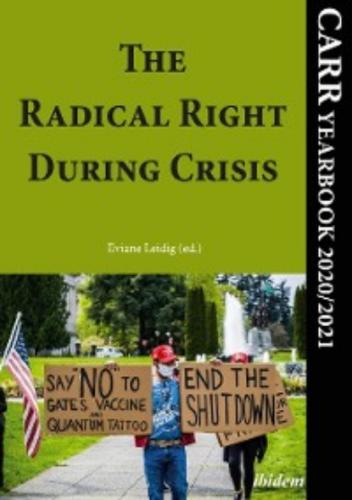The Radical Right During Crisis. Группа авторов
Europe, with chapters in a variety of countries such as Argentina, Belarus, Chile, Germany, Italy, Poland, Russia, Serbia, Spain, and Switzerland. Operating as a loose network, GLF is held together by a shared ideological programme as well as a common “branding”.
The latter is visible in their appropriation of the life rune and/or the Black Sun as their logotypes,5 through which GLF’s chapters have been recognizable at marches and other offline activities, as well as in their online communication. In addition, such branding points straight to the group’s ideological core which is concisely visible on their international webpage.6
The webpage offers not only several posts conveying an (eco-)fascist message, but also a mission statement which serves as an exemplary formulation of the eco-fascist doctrine. According to it, GLF is a nationalist movement rejecting anthropocentrism and monotheism. By asserting the importance of Blood and Soil (‘Earth’s being not just a lifeless piece of stone, but the Mother of every creature alive, mother of humanity’),7 GLF accentuates the naturalistic-organicistic imaginary of beings rooted in the nation’s soil. This includes asserting the importance of intergenerational continuity and a bond with nature, a bond which should not be overstretched as a condemnation of overpopulation, as the group’s 10-points manifesto makes clear.8 Building on these sentiments, GLF presents itself as the “ecological alternative” to profit-seeking individualism and materialism, and also incorporates animal ethics through veganism and calls for animal liberation.9 Furthermore, the content posted on GLF page outlets makes references to Pentti Linkola, the recently deceased Finnish eco-fascist deep ecologist;10 the American National Socialist author William Pierce;11 Hitler’s Priestess12 Savitri Devi;13 and to notable Nazis such as Walther Darré14 or Alwin Seifert, who is referred to as the “First German Environmentalist”.15 As a matter of fact, the German racial policies of the 1930s are described as ‘the attempt to resurface the Weltanschauung of the ancient Germanic people’.16 Consequently, GLF rejects democracy (the “religion of death”) and embraces violence as an indispensable part of the struggle for restoring an imagined equilibrium in and with nature.
And yet, GLF has not only proclaimed the need to restore such an imagined equilibrium but has also frequently report relevant activism, what Zbyněk Tarant refers to as far-right “eco-activism” or “eco-actions”.17 For example, GLF’s chapters have repeatedly reported on clean-ups18 as well as suggested to build a bird feeder19 and to raise oak trees,20 thus putting an emphasis on direct action and hands-on experience well-established in radical right activism. These illustrative examples are taken from the German variant which also illustrates shifting levels of (public) activism: for instance, its vk.com channel, opened in 2016 but left untouched since 2017.21 The variant has recently returned to Twitter and made available a webpage, although both are seemingly deserted again.22 Indeed, GLF’s eco-fascist “unique selling point” and raison d’être might not be enough to stabilize such groupuscules23 in the medium—and long-run—as is also visible in one of their Polish interviewee’s words: ‘Greenline Front died of “natural causes”, people didn’t do anything’.
The short-lived case of GLF may be emblematic of eco-fascist and radical right cells, sentenced to atomized and disjointed activism and operating remotely from most radical right organizations. However, the case of GLF raises at least two issues worth considering about the relationship between the radical right and ecologism. First, although many radical right actors have taken a contrarian position when it comes to anthropogenic climate change,24 the current relevance of environmental issues has let some of these actors to show increasing interest in the environment. While this is not necessarily congruent with eco-fascism, elements such as purity of the national land and rootedness of an essentialised collective may also be found in more subtle forms of radical right ideology. Thus, studying “proper” eco-fascism might sharpen our awareness of related, though different, articulations of nature protection across the radical right spectrum.
Second, even though GLF did not permeate into mainstream environmental networks and might not even attract significant support within the radical right, its grassroots activism keeps alive a fascist tradition of ecological thought and practice. Moreover, this ecological moment points to the importance of critically examining environmentalist framing. That is, GLF and eco-fascism at large question our understanding of environmentalism and ecologism as framing done by mainstream and left-wing environmentalists too might unconsciously reproduce potentially troubling notions of eco-organicism and an imagined equilibrium in and with nature, resulting in exclusionary politics.
Dr Bernhard Forchtner is a Senior Fellow at CARR and associate professor of media and communication at the University of Leicester.
Balša Lubarda is a Doctoral Fellow at CARR and doctoral candidate in environmental sciences and policy at the Central European University.
1 Peter Staudenmaier, “Fascist Ecology: The ‘Green Wing’ of the Nazi Party and its Historical Antecedents,” in Ecofascism Revisited: Lessons from the German Experience, eds. J. Biehl and P. Staudenmaier (Porsgrunn: New Compass Press, 2011), 13-42.
2 Bernhard Forchtner, “Eco-fascism: Justifications of Terrorist Violence in the Christchurch Mosque Shooting and the El Paso Shooting,” openDemocracy, August 13, 2019, https://www.opendemocracy.net/en/countering-radical-right/eco-fascism-justifications-terrorist-violence-christchurch-mosque-shooting-and-el-paso-shooting/.
3 Balša Lubarda, “Beyond Ecofascism? Far Right Ecologism (FRE) as a Framework for Future Inquiries,” Environmental Values 29, no. 6 (2020): 713-32.
4 Bernhard Forchtner, ed., The Far Right and the Environment. Politics, Discourse and Communication (Oxon: Routledge, 2019).
5 Greenline Front Ukraine, vk, January 11, 2021, 9:10 a.m., https://vk.com/greenline_kyiv?z=photo-74403565_341755028%2Falbum-74403565_0%2Frev. On the life rune as a symbol, see “Life Rune,” Anti-Defamation League, https://www.adl.org/education/references/hate-symbols/life-rune.
